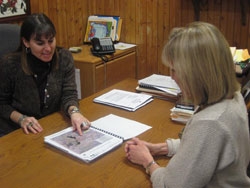Below you will find a number of frequently asked questions and answers. Can't find what you are looking for? Please fill out the form at the bottom of this page to request any information you need.
What is Farmland Assessment?
Farmland Assessment is a special method of property tax assessment in the State of New Jersey that provides for a reduced assessment for land that is actively devoted to agriculture. By qualifying cropland, pasture land, and forests under Farmland Assessment, a private landowner can legally reduce the amount of property taxes they pay each year.
How much will my gross savings be under Farmland Assessment?
For vacant land, this is easy to calculate. On average, an acre of cropland (including Christmas trees, orchards, nursery) may be assessed at about $800 +/- $200 per acre. Pastureland may be assessed at about $200/acre, and woodlands generally will not be assessed at more than $150/acre. Apply these values to your property to determine your potential assessed value, and then multiply by the tax rate to determine what you might be paying in property taxes annually. Compare this to your current tax bill to determine your potential savings.
This gets substantially more difficult if there is a house on the property, as the tax assessor has a certain amount of latitude in determining the value of the land underneath the homesite (since the value of the improvements are not affected by Farmland Assessment). Since every tax assessor does this in a slightly different way, we recommend that you contact your local tax assessor to get an estimate from them as far as what your gross tax savings would be.
How much will my net savings be under Farmland Assessment?
Once you determine your gross savings, we will help you understand the costs involved in the Farmland Assessment process. It is important to realize that Farmland Assessment requires actions by the landowner in order to prove that their land is actively devoted to agriculture. Since every property is different, we would need to understand your situation before we were able to give you an idea of what your annual costs might be (in terms of money spent and time devoted).
Do I need a Forest Management Plan?
A Forest Management Plan (often referred to as a woodland management plan or forest stewardship plan) is required by the Farmland Assessment Act if your property is more than 50% wooded. At that point, the law mandates that a landowner prove that their woodland is actively devoted to agriculture, and having a Forest Management Plan is one of the steps.
Other landowners may also desire to have and follow a Forest Management Plan. Farmers in the NJ Highlands who wish to cut firewood or timber (or otherwise manage their woodland) are exempted from the permitting requirements of the Highlands Act if they are following a Forest Management Plan that is approved by the State Forester. Public landowners and non-profit organizations are increasingly understanding the multiple benefits of practicing forestry on preserved land or otherwise tax-exempt land. Other landowners may not be specifically interested in Farmland Assessment, but wish to manage their forests wisely or be exempted from local tree cutting ordinances.
How do I start the process?
Contact one of the foresters of Gracie & Harrigan at (908) 781-6711 or fill out our contact form at the bottom of this page.
Is there a deadline I need to be concerned with?
The deadline for filing for Farmland Assessment is August 1 each year. For all clients, Gracie & Harrigan will send out a reminder and instructions at the end of May. The local municipality will also likely send you blank forms during the month of June. August 1 is a firm deadline!!! There are no extensions, unless there is a death or incapacitation of the landowner.
If you are interested in getting into Farmland Assessment, but have missed the August 1st deadline, there is an opportunity to file paperwork before December 31st.
How long does it take to receive the reduced assessment?
You must complete two qualifying years before receiving the reduced assessment.
For example, if you submit an application in July 2010, your first qualifying year will be 2011. Your second qualifying year will be 2012, and you should see the reduced assessment as of January 1, 2013.
Isn’t there something about making $500 a year?
Under traditional Farmland Assessment, there is both an annual activity requirement and income requirement. The annual income requirement is $500 for the first 5 acres, $5 for each additional acre of cropland or pasture, and $0.50 for each additional acre of woodland.
Didn’t the State do something to get rid of the income requirement?
In January 2010, Governor Corzine signed the NJ Forest Stewardship Act. However, that Act does not take effect until January 2011, and the regulations that will implement that Act have not been written yet. For a complete list of answers to frequently asked questions regarding the NJ Forest Stewardship Act,
please click here.
Do I get money back from the government if I have a forest stewardship plan?
The federal government and soon the state government have cost-sharing programs for private landowners who pay for a forest stewardship plan. However, those funds are subject to availability, and we have found various federal cost-sharing programs to be unpredictable. Therefore, Gracie & Harrigan does not guarantee that you will receive funding from either the federal or state government for any cost-share program. There are also terms and conditions for receiving these funds that are specified by each program that a landowner must be aware of before applying.







